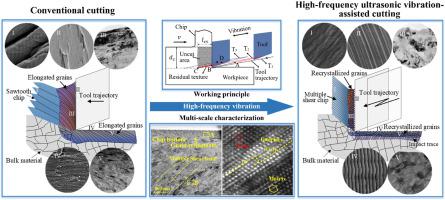International Journal of Machine Tools and Manufacture ( IF 14.0 ) Pub Date : 2023-08-04 , DOI: 10.1016/j.ijmachtools.2023.104064 Xiaoliang Liang , Canbin Zhang , Chi Fai Cheung , Chunjin Wang , Kangsen Li , Benjamin Bulla

|
Although the intermittent contact by the ultrasonic vibration-assisted cutting explained the machinability advantages, there exists a research gap in concentrating the effects of high-frequency ultrasonic vibration-assisted cutting (HFUVAC). This work clarified the differences of the micro/nano incremental material removal mechanisms between conventional cutting (CC) and high-frequency ultrasonic vibration-assisted cutting of 316 L stainless steel. The machinability advantages and microstructure features were compared and analyzed through the ultra-precision cutting experiments. Compared with the continuous contact mode of the conventional cutting, the incremental effect of the high-frequency ultrasonic vibration-assisted cutting achieved superior machinability, which included cutting force decreasing, tool wear reduction, surface defects suppression, and chips undergoing from discontinuous quasi-shear state to continuous multiple-shear state. As the nominal cutting speed increased in the high-frequency ultrasonic vibration-assisted cutting, the surface defects and surface roughness showed an increasing trend, which was indispensable to control the normal cutting speeds below 5 m/min, or the cutting stroke in each vibration cycle less than 800 nm to obtain the defect-free surface. The grain refinement and severe elongation deformation were observed at the chip bottom and machined surface of the conventional cutting due to strong mechanical friction loads. While the microstructure features of chips and the machined surface in the local deformation layer were the results of friction reduction, dynamic recrystallization, and twinning/stacking formation induced by the incremental effects of the high-frequency ultrasonic vibration-assisted cutting. The results help to improve surface quality and optimize the ratio of cutting speed to vibration frequency to enhance the efficiency.
中文翻译:

316L不锈钢高频超声振动辅助切削微纳增量材料去除机制
尽管超声波振动辅助切削的间歇接触解释了切削加工性的优势,但在集中高频超声波振动辅助切削(HFUVAC)的效果方面还存在研究空白。该工作阐明了316L不锈钢的常规切削(CC)和高频超声振动辅助切削的微纳增量材料去除机制的差异。通过超精密切削实验,对比分析了其切削加工性能优势和显微组织特征。与传统切削的连续接触方式相比,高频超声振动辅助切削的增量效应实现了优越的切削加工性,包括切削力降低、刀具磨损减少、表面缺陷抑制,切屑从不连续准剪切状态转变为连续多重剪切状态。随着高频超声振动辅助切削中名义切削速度的增加,表面缺陷和表面粗糙度呈增加趋势,这对于将正常切削速度或每次振动的切削行程控制在5 m/min以下是必不可少的周期小于800 nm以获得无缺陷的表面。由于强机械摩擦载荷,传统切削的切屑底部和加工表面出现晶粒细化和严重的伸长变形。而局部变形层切屑和加工表面的显微组织特征是减摩、动态再结晶、高频超声振动辅助切割的增量效应引起的孪生/堆叠形成。研究结果有助于提高表面质量并优化切削速度与振动频率的比率以提高效率。












































 京公网安备 11010802027423号
京公网安备 11010802027423号